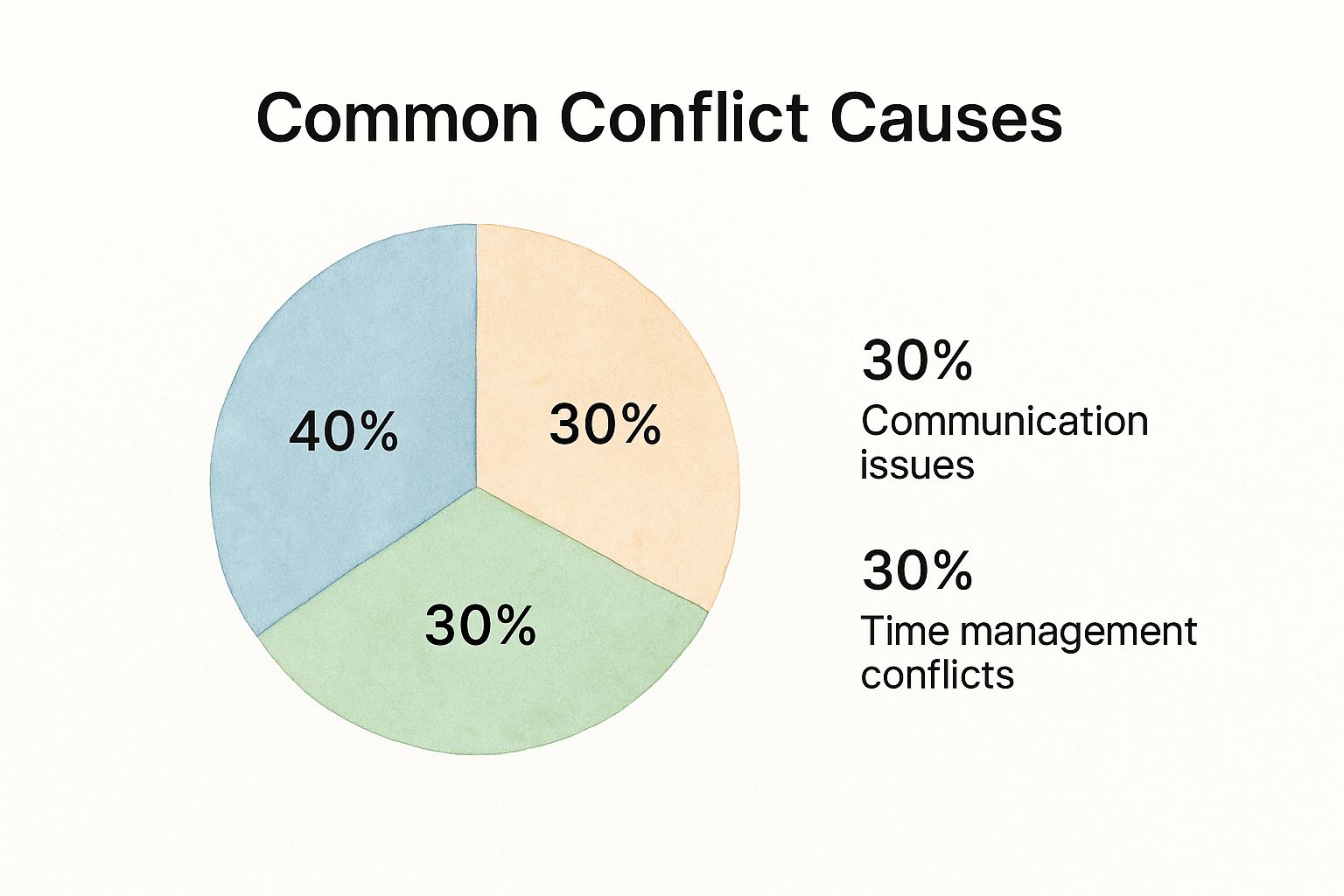Let’s get one thing straight: every single couple argues. The idea that a happy relationship is a conflict-free one is a total myth. The real difference between couples who make it and those who don’t isn't whether they fight, but how they fight.
Destructive arguments are all about winning. They’re full of blame, criticism, and emotional walls. But constructive conflict? That's about teamwork. It’s you and your partner against the problem, not against each other. Learning to handle disagreements this way turns them from potential deal-breakers into chances to grow closer.
From Destructive Patterns to Constructive Dialogue
The secret is shifting your entire mindset. You have to move away from those knee-jerk, harmful reactions and deliberately choose healthier ways to communicate when things get tense.
The most successful couples don’t avoid arguments; they’ve just learned how to argue better. They see conflict not as a battle, but as a signal that something in the relationship needs attention and care.
So, what are most couples even fighting about? This infographic nails the most common sources of friction.

It’s no surprise that communication breakdowns, money stress, and arguments over time are the big three. If you can learn to talk through these specific issues constructively, you’re already way ahead of the game.
The Science Behind Successful Conflict
The research on this is fascinating and incredibly clear. A massive analysis of over 3,000 couples discovered that 69% of satisfied partners consistently use constructive dialogue to manage their conflicts. On the flip side, 79% of unhappy couples get stuck in destructive patterns like criticism and defensiveness.
In fact, that same research identified four behaviors that are so toxic they can reliably predict a breakup: criticism, contempt, defensiveness, and stonewalling (the silent treatment). Psychologists call these "The Four Horsemen," and learning to spot them is the first step toward getting them out of your relationship. You can learn more about these global conflict patterns to better understand your own dynamics.
Spotting these toxic habits in the heat of the moment is tough, but replacing them with healthier alternatives is what separates the couples who thrive from those who fall apart.
Here’s a quick look at those destructive patterns versus what you should be doing instead.
Destructive vs. Constructive Conflict Approaches
| Destructive Pattern (The Four Horsemen) | Constructive Alternative |
|---|---|
| Criticism: Attacking your partner's character ("You're so lazy"). | Gentle Start-Up: Using "I" statements to describe how you feel about a specific action ("I feel overwhelmed when the dishes pile up"). |
| Contempt: Expressing disgust through sarcasm, eye-rolling, or name-calling. | Build a Culture of Appreciation: Actively express respect, fondness, and gratitude for your partner, even during a conflict. |
| Defensiveness: Making excuses or playing the victim to deflect blame. | Take Responsibility: Acknowledge your part in the problem, even if it’s small. An apology can go a long way. |
| Stonewalling: Shutting down and refusing to engage in the conversation. | Physiological Self-Soothing: Recognize when you're overwhelmed, agree to take a short break (at least 20 minutes), and then come back to the conversation. |
Moving from the left column to the right column takes practice and a real commitment from both partners. It's a skill, and like any skill, it gets easier and more natural the more you do it.
Getting to Know Your Personal Conflict Triggers

Before you can get a handle on arguments in your relationship, you have to know what lights your own fuse. We all have conflict triggers—those specific words, topics, or even tones of voice that almost guarantee a bad emotional reaction. These are deeply personal, often tangled up in our past experiences and fundamental needs.
Think of it like an emotional landmine. For one person, it might be a dismissive eye-roll. For another, it's a specific phrase like, "You always…" that instantly puts them on the defensive. Pinpointing your own patterns is the first real step toward managing them.
This takes some honest self-reflection. The next time you feel that flash of anger or hurt, take a beat. Ask yourself what really just happened. Was it what your partner said, or was it the way they said it? Getting clear on these moments helps you see the conflict for what it is, not just what it feels like.
What's Your Go-To Conflict Style?
When disagreements pop up, everyone has a default way of reacting. See if any of these sound like you:
- The Collaborator: You see a fight as a problem to solve together. You're all about finding a solution where you both feel like you've won.
- The Avoider: Tension is your worst enemy. You'd rather do almost anything to sidestep an argument, even if it means your own needs get pushed aside.
- The Competitor: For you, conflict is a battle to be won. The main goal is proving your point, not necessarily finding common ground.
- The Accommodator: You’re quick to give in to what your partner wants just to keep the peace, often putting your own feelings last.
Figuring out your dominant style—and your partner's—can be a huge eye-opener. It’s not just interesting; it’s critical. Research consistently shows that how couples handle conflict dramatically affects their happiness. One major analysis found that couples who used collaborative strategies reported 40-60% higher relationship satisfaction than those who relied on avoidance or competition.
Understanding your triggers isn't about blaming your partner for setting you off. It’s about owning your reactions so you can express them calmly instead of letting them explode.
For example, if you know that feeling unheard is a massive trigger for you, you can learn to say, "I'm starting to feel like I'm not being heard right now, and I need a moment." That’s a world away from just lashing out in frustration. This kind of reaction can sometimes cause a partner to pull back, which adds another layer of confusion. If you've ever wondered about this dynamic, it might be helpful to understand why men pull away when things get heated. Our personal histories shape our reactions, and being vulnerable enough to share that can build a much stronger, more understanding relationship.
Mastering The Art Of Calm Communication

Once you've pinpointed what sets you off, the real work begins. Let's be honest, communicating effectively during a fight isn't about finding the perfect, magic words. It’s all about creating an atmosphere of safety and mutual respect, especially when your emotions are running high.
The goal is to talk with your partner, not at them. This starts with a simple but profound shift in how you frame things.
One of the most powerful tools I've seen work for couples is the “I” statement. It’s a small change that can completely re-route a conversation from blame to vulnerability. For example, instead of firing off, “You never listen to me,” which will almost certainly make your partner defensive, try this: “I feel unheard when we’re talking about this.”
See the difference? You're sharing your emotional reality without pointing a finger. This simple tweak makes it much easier for your partner to actually hear you.
Listen To Understand, Not Just To Reply
Active listening is a relationship superpower. It’s so much more than just waiting for a gap in the conversation so you can jump in with your point. It’s a genuine, focused effort to understand where your partner is coming from, validate their feelings, and confirm you've got it right.
The biggest communication problem is we do not listen to understand. We listen to reply. When we listen with curiosity, we don’t listen with the intent to reply. We listen for what's behind the words.
A practical way to do this is to simply reflect back what you heard. Try saying something like, “Okay, so what I’m hearing you say is that you feel completely overwhelmed right now. Is that right?” This does two critical things: it shows your partner you're truly listening, and it nips any misunderstandings in the bud before they can escalate things further.
The Power Of A Strategic Pause
Sometimes, the smartest thing to do in a heated argument is to stop talking. Seriously. Calling a strategic timeout isn't a sign of weakness or running away from the problem. It’s an essential tool for emotional regulation that gives you both a chance to cool off and come back with clearer heads.
There's science to back this up. Practicing calming techniques like deep breathing during a conflict can lower cortisol levels by up to 30%. In fact, disagreements that are handled with emotional regulation are 50% more likely to end with both people feeling understood. You can discover more insights about emotional regulation and conflict to see just how effective this is.
Before you need it, agree on a signal for a timeout—a word or a gesture. Take at least 20 minutes apart to do something completely unrelated and calming. Then, and this is the crucial part, commit to coming back to the conversation later.
Finding Solutions Beyond Compromise
Getting to the negotiating table is one thing; actually building a lasting solution together is another. This is where you pivot from just talking about the problem to actively fixing it as a team. The goal isn’t to land on a simple compromise where you both walk away having given something up. It's about digging deeper to find a genuine "win-win" where both of you feel your most important needs are seen, respected, and met.
A lot of couples see compromise as the ultimate prize, but it often leaves both people feeling just a little bit cheated. A far better approach is to reframe the problem as a shared project you're tackling together. What many don't realize is that research shows a staggering 69% of relationship problems are perpetual. These aren't issues you solve once and for all; they're recurring themes that need ongoing management. Learning how to handle conflict in relationships effectively means moving past the idea of a quick fix and learning to navigate these challenges collaboratively for the long haul.
Moving from Gridlock to Dialogue
It’s easy to get "gridlocked" on an issue. This is that frustrating hamster wheel where you have the same argument over and over with zero progress. It usually happens when the conflict pokes at something much deeper—a core value or a lifelong dream for each person. Breaking this cycle requires a much deeper level of understanding.
Take a classic conflict over money, for instance. One partner is laser-focused on saving for a house (representing their dream of security), while the other wants to spend more on travel (their dream of freedom and new experiences). A bland compromise—save a little less, travel a little less—is going to feel like a loss for both of them.
The goal is to get curious, not furious. Explore the ‘why’ behind each other's position. What core need or lifelong dream is fueling this desire? Understanding this turns an adversary into a person with dreams you can support.
Instead of just haggling over budget percentages, the real work is in exploring those underlying dreams. The aim is to find a creative path forward that honors both visions for a happy life.
A Framework for Collaborative Solutions
Once you truly understand what’s at stake for each other, you can start brainstorming solutions that feel good to both of you. The partner who needs security might feel much more at ease with a detailed, automated savings plan in place. Meanwhile, the partner who craves experiences might be perfectly happy planning one incredible, meaningful trip each year instead of several smaller, less impactful ones.
Here’s a practical way to approach it:
- Define the Problem Together: Get on the same page about what the core issue really is, without pointing fingers.
- Explore the Dreams: This is the crucial part. Each of you explains the "why" behind your stance. What does this really represent for you? What’s the dream underneath the demand?
- Brainstorm Without Judgment: Throw every possible idea onto the table, no matter how wild or silly it sounds. The goal is quantity over quality at this stage.
- Find the Overlap: Sift through the ideas to find the ones that honor both of your core needs. Where's the common ground?
This process transforms a nasty fight about money into a productive conversation about how to build a life that feels both secure and adventurous—for both of you.
How to Reconnect and Repair After a Fight

The shouting might be over, but the argument isn't really finished. The most crucial part of navigating conflict is what comes next: the repair. Without it, resentment festers and creates a quiet distance that can pull you apart over time. This stage is all about mending hurt feelings and consciously reinforcing your bond.
A genuine apology is where it all starts. This isn't about muttering a reluctant "sorry" just to move on. It’s about true ownership. A sincere apology means you see your part in the mess and you genuinely regret the pain it caused.
Think about the difference. Saying, “I’m sorry I raised my voice; that wasn’t fair to you,” is worlds away from, “I’m sorry, but you were pushing my buttons.” One takes responsibility, while the other just deflects blame.
Strategies for Rebuilding Your Connection
Words are a start, but actions are what truly rebuild trust and warmth. You have to show your partner you’re back on the same team, not just say it. Even small gestures can work wonders to diffuse any lingering tension.
Here are a few practical ways to reconnect:
- Share Physical Touch: A simple hug, holding hands while you watch TV, or even just sitting close can re-establish that physical connection and signal safety.
- Express Appreciation: Make a point to tell your partner something you love or appreciate about them. This intentionally pivots the dynamic away from the recent conflict and back to the positive foundation you’ve built.
- Validate Their Feelings: You don’t have to agree with their side of the story to validate how they feel. Something as simple as, “I can see why that was so upsetting for you,” shows you’re trying to understand and makes them feel heard.
Repair isn’t just about getting over one fight. It’s about using a negative moment as a powerful chance to learn more about each other, grow closer, and ultimately build a more resilient partnership.
This process makes the relationship stronger and better equipped for whatever comes next. For some, the damage might have already led to a breakup. Understanding these repair skills is still vital. If you’re navigating that difficult territory, our guide on getting back together with an ex has more specific advice for that journey.
Answering Your Conflict Questions
Even with the best game plan, some situations just leave you feeling stuck. When you're trying to work through a disagreement, a lot of tricky questions pop up that don't have simple, one-size-fits-all answers. Let's walk through a couple of the most common ones I see.
What If My Partner Won't Talk?
When your partner completely shuts down or stonewalls you, the absolute worst thing you can do is push harder. Trust me on this. This reaction isn't usually about a lack of care; it's a sign that they are completely and utterly overwhelmed. Forcing a conversation right then and there will only crank up their stress and make them retreat even further.
Instead, give them an out that includes a clear plan to come back to the issue. Try saying something like, “I can see you’re not up for talking about this right now. Let’s take a 30-minute break, and we can check back in then.” This approach respects their need for space while making it clear you haven't just dropped the problem.
The goal isn’t to solve the problem on the spot. It’s to make it safe to eventually talk about it. Giving your partner space shows you respect their emotional state, which is a huge step in building the trust needed for tough conversations down the road.
How Do We Argue When We're Apart?
Conflict can feel 10 times more intense in a long-distance relationship. You can't rely on a simple hug or physical touch to bridge the gap after a tough talk. Tone gets completely mangled over text, and it's shockingly easy for a tiny misunderstanding to blow up into a massive fight.
Whenever you sense a serious conversation coming on, do everything you can to move it to a video call. Seeing each other's faces and expressions makes a world of difference.
You also have to be way more intentional about making up. If you've had a difficult chat, make a real, concrete plan to reconnect later. Maybe it's a fun virtual date night or just a call where you agree to only talk about your day, no heavy stuff. It takes a unique set of skills to navigate these challenges, and you can find more long-distance relationship tips to help you stay close. Remember, being apart doesn't have to mean growing apart.
At Poke Match, we provide expert insights to help you build stronger, more meaningful connections. For more advice on navigating the complexities of modern dating and relationships, explore our articles at https://poke-match.com.
